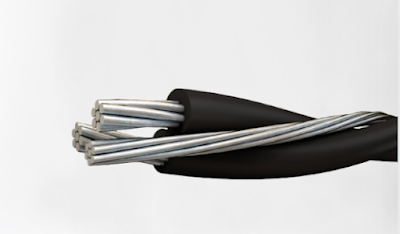How to Choose the Right Triplex Cable for Your Project
Triplex wire, commonly referred to as triplex cable, is a kind of electrical cable that has three conductors flatly twisted together.
To stop electrical current from leaking or shorting out, each conductor is typically constructed of copper or aluminum and is insulated with a premium substance. Next, a flat configuration of the three conductors is formed, with an outer layer of insulation and a protective covering.
How a triplex electrical cable look alike
Triplex cable typically has three insulated conductors arranged side by side on a flat wire. Typically, different colors are used to distinguish each conductor, making it easier to see them.
Then, an outer layer of insulation and a protective covering are placed on top of the three conductors, which have been bundled together in a flat configuration.
To add more defense against the elements and physical harm, the outer layer can be jacketed with different materials like PVC or HDPE. Depending on the particular requirements of the project, triplex cables can be found in a variety of sizes and types.
A triplex cable has a generally uncomplicated and easy appearance, yet it is essential for providing electrical power to numerous applications in a safe and effective manner.
7 Factors to keep in mind while choosing a triplex wire
Check voltage rating
Triplex cables are available in a variety of voltage ratings, which show the highest voltage that the cable is capable of safely handling.
It's crucial to pick a cable whose voltage rating is suitable for your project. You should examine the voltage specifications of your equipment and select a cable with a voltage rating that is equal to or higher than those specifications.
Ampacity
The amount of electrical current that a cable can safely carry is referred to as its ampacity. Usually, this is expressed in amperes (A).
It is crucial to select a cable with the right ampacity grade for your project because utilizing a cable with inadequate ampacity might result in overheating, cable breakage, and even a possible fire hazard.
You should examine the ampacity specifications of your equipment and select a cable whose ampacity rating is equal to or higher than those specifications.
Material of the conductor
The component of the cable that carries the electrical current is called the conductor, and it is made of metal. Different conductor materials, such as copper or aluminum, can be used to create triplex cables. Although copper conductors cost more than aluminum conductors, they are more durable and have better conductivity.
Aluminum conductors are less expensive, lighter, and more brittle than copper conductors, but they also have lower conductivity. The precise requirements of your project and the available budget will determine the conductor material that you use.
Insulation
The material that encircles each conductor and stops electrical current from leaking or shorting out is known as insulation.
Different materials, including polyethylene, cross-linked polyethylene (XLPE), and ethylene propylene rubber (EPR), can be used to insulate triplex cables.
The insulating material you choose will depend on the particular requirements of your project, such as the temperature and environmental factors to which the cable will be exposed.
Jacket Composition
The cable's jacket, which is its outer covering, offers additional protection against physical harm and environmental variables.
Different materials, such as polyvinyl chloride (PVC), thermoplastic elastomer (TPE), or high-density polyethylene (HDPE), can be used to jacket triplex cables. The precise requirements of your project, such as the circumstances under which the cable will be utilized, will determine the jacket material to be chosen.
Length of the cable
A cable that is available in the requisite length should be selected after determining the length of the cable required for your project. By doing this, you can be certain that you will have enough cable to finish your job without running out of it or needing to splice wires together.
Price
The price of the cable should be taken into account, but it's crucial to avoid compromising quality for a cheap price.
It's crucial to pick a cable that satisfies the requirements of your project while staying within your budget because selecting a cable that is too inexpensive could lead to subpar performance or even safety risks.
Conclusion:
Choosing the right triplex electrical wire is crucial for ensuring safe and reliable electrical operation in your project. By carefully considering these factors.
Investing in a high-quality triplex cable not only ensures proper electrical operation but can also help reduce maintenance costs in the long run.
So take the time to evaluate your project's requirements and choose quality triplex wires that meet those needs for optimal performance and safety.
Znergy Cable is an electrical cable manufacturer based in Brisbane, Australia. We specialize in providing high quality electrical cables for all type of industries. The company specializes in providing high-quality cabling solutions for a variety of industries, including telecommunications, data centers, and industrial automation.
Znergy Cable is a cable manufacturer based in Brisbane, Australia. We manufacture and supply Low Voltage to High Voltage Cables and any specialist cables for Mining, Fire, LSZH, Shipping, Instrumentation, Oil & Petro-chemical, Gas, Solar, Undersea submersible and industrial cables.




Comments
Post a Comment